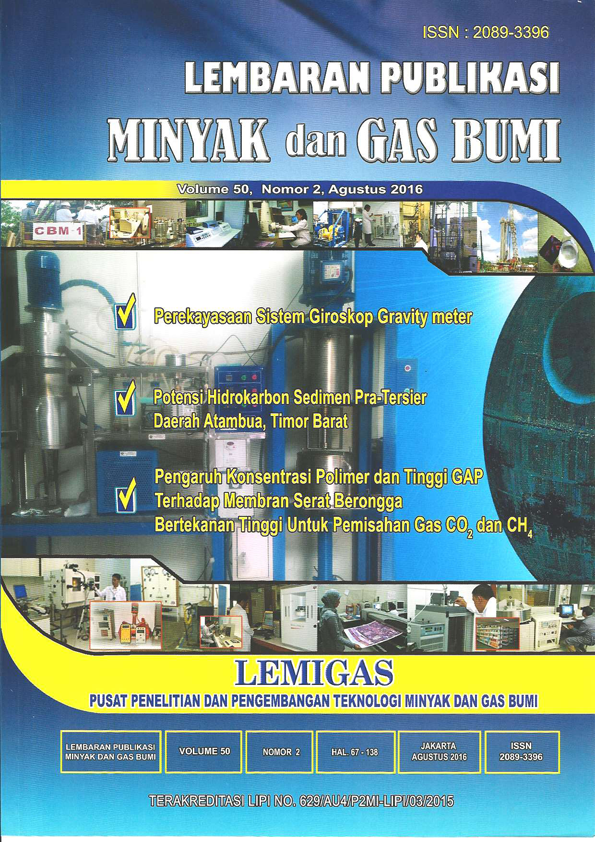Pengaruh Konsentrasi Polimer dan Tinggi GAP Terhadap Membran Serat Berongga Bertekanan Tinggi Untuk Pemisahan GAS CO, DAN CH
DOI:
https://doi.org/10.29017/LPMGB.50.2.716Kata Kunci:
membran serat berongga, formamida, ketahanan tekan, selektivitas.Abstrak
Telah dilakukan pembuatan membran serat berongga dengan bahan dasar polimer berupa campuran selulosa asetat dan polietilena glikol. Dikarenakan tidak dapat dibuat nozzle dengan diameter kurang dari 0.2 mm, peningkatan ketahanan tekan dilakukan dengan memvariasikan formamida, spinneret, konsentrasi dan berat molekul polietilen glikol (PEG) dalam larutan polimer. Komposisi formamida 6%, PEG 10% dengan berat molekul 4000 berhasil meningkatkan ketahanan tekan membran serat berongga sampai 400 psi yang dicetak menggunakan spinneret modifikasi iii. Keberadaan formamida yang lebih besar dalam larutan polimer relatif tidak berpengaruh terhadap selektivitas. Diperoleh beberapa komposisi dengan selektivitas yang baik dimana CH, tidak lewat dan CO, lewat dengan permeabilitas sekitar 107 cm (STP).cm.cm2.cmHg'Referensi
Adiwar, 2007. Efek of Delayed Evaporation In Cellulosa Acetate Membrane Preparation to Separate CO/CH, at Low Pressure, Lemigas Scientific Contribution, Vol 32. No. 3, 162-168.
Adiwar, 2009. Efek Poli Etilen Glikol Cair Terhadap Selektivitas Membran Selulosa Asetat untuk Pemisahan CH, Dan CO, Pada Tekanan Rendah, Lembaran Publikasi lemigas. Vol 43 No. 3, 2009. 177-185.
Adiwar, 2012. Pembuatan Unit Peralatan Pembuat Membran Serat Berongga. Laporan Akhir DIPA 2012.
Adiwar, 2015. Pengaruh ukuran nozzle spinneret terhadap ketahanan tekan dan selektifitas membran serat berongga untuk pemisahan gas CO, pada tekanan rendah.
Baker Richard W., 2002. Future Directions of Membrane Gas Separation Technology. Ind. Eng. Chem. Res. 2002, 41, 1393-1411 1393.
Bernardo, P. Drioli, E., and Golemme, G., 2009. Membrane Gas Separation: A Review/State of the Art. Ind. Eng. Chem. Res., 48, 4638-4663.
Cut Meurah Rosnelly, 2012. Pengaruh Rasio Aditif Polietilen Glikol Terhadap Selulosa Asetat pada Pembuatan Membran Selulosa Asetat Secara Inversi Fasa. Jurnal Rekayasa Kimia dan Lingkungan Vol. 9, No. 1, hal. 25- 29,ISSN 1412-5064.
D.O. Cooney, and C.C. Jackson., 1987. Gas Absorption in a hollow fibre device, Chemical Engineering Communication, 61, pp. 159-167.
Du, N. Y., Park, H. B., Dal-Cin, M. M., and Guiver, M. D., 2012. Advances in High Permeability Polymeric Membrane Materials for CO, Separations. Energy Environ. Sci., 5, 7306-7322.
Eric P. Robertson, 2007. Analysis of CO, Separation from Flue Gas, Pipeline Transportation, and Sequestration in Coal. U.S. Department of Energy. Idaho National Laboratory. Idaho Falls, Idaho 83415.
F. Falbo, F. Tasselli, A. Brunetti, E. Drioli and G. Barbieri, 2014. Polyimide Hollow Fiber Membranes For CO, Separation From Wet Gas Mixtures. Brazilian Journal of Chemical Engineering. ISSN 0104-6632. Vol. 31, No. 04, pp. 1023 - 1034.
Koros, W. J., Mahajan, R., 2000. Pushing the Limits on Possibilities for Large Scale Gas Separation: Which Strategies? J. Membr. Sci., 175, 181-196.
Leopold Braeuer, 2009. Membranes for CO2 removal at a natural gas plant: pretreatment challenge, solution and operating experience. uopTM www. UOP.com.
Lively, R. P., Chance, R. R., Kelley, B. T., Deckman, H. W., Drese, J. H., Jones, C. W., and Koros, W. J., 2009. Hollow Fiber Adsorbents for CO2 Removal from Flue Gas. Ind. Eng. Chem. Res., 48, 7314-7324.
Mulder M., 1996. Basic Prinsiple of Membrane Technology. Second Edition. Kluwer Academic Publisher. Netherlands.
Syahril Ahmad, 2012. Pengaruh Annealing pada Sifat Membran Folisulfon Serat Berongga. Prosiding Simposium Nasional Polimer II. ISSN 1410-8720
Vu, D. Q., Koros, W. J., and Miller, S. J., 2002. High Pressure CO2/CH4 Separation Using Carbon Molecular Sieve Hollow Fiber Membranes. Ind. Eng. Chem. Res. 2002, 41, 367-380.
Xuezhong H. and May-Britt Hägg., 2014. CO, Removal from High Pressure Natural Gas Using a Novel Fixed-site-carrier Membrane. 3rd Trondhim. Gas Tecnology Conference. Department of Chemical Engineering, Norwegian University of Science and Technology (NTNU).











